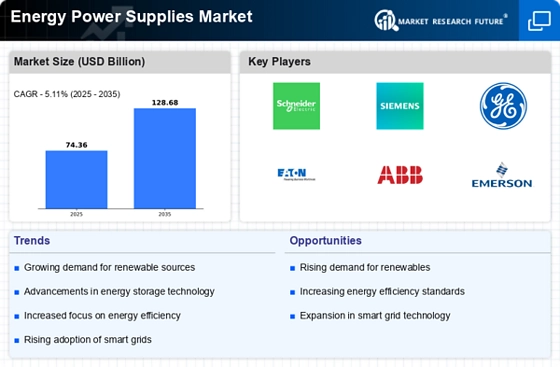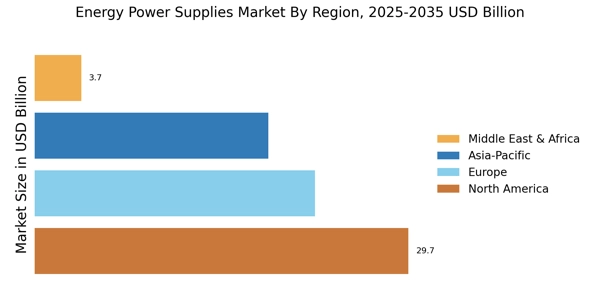Government Incentives and Policies
Government incentives and policies play a crucial role in shaping the Energy Power Supplies Market. Many governments are implementing favorable policies to promote the adoption of renewable energy and energy-efficient technologies. For instance, tax credits, grants, and subsidies for renewable energy projects are becoming increasingly common, encouraging investments in energy power supplies that align with these initiatives. In 2025, it is projected that government funding for renewable energy projects will exceed $100 billion, significantly impacting the market dynamics. This supportive regulatory environment not only stimulates demand for innovative power supply solutions but also encourages collaboration between public and private sectors, fostering growth within the Energy Power Supplies Market.
Rising Demand for Renewable Energy
The increasing emphasis on renewable energy sources is a pivotal driver for the Energy Power Supplies Market. As nations strive to meet sustainability goals, the demand for energy power supplies that support solar, wind, and other renewable technologies is surging. In 2025, the renewable energy sector is projected to account for over 30% of total energy consumption, necessitating advanced power supply solutions. This shift not only enhances energy security but also reduces reliance on fossil fuels, thereby fostering a more sustainable energy landscape. Consequently, manufacturers in the Energy Power Supplies Market are innovating to develop products that cater to the unique requirements of renewable energy systems, ensuring compatibility and efficiency.
Growing Awareness of Energy Efficiency
The rising awareness of energy efficiency among consumers and businesses is a notable driver for the Energy Power Supplies Market. As energy costs continue to rise, there is a growing emphasis on reducing energy consumption and optimizing power usage. In 2025, it is estimated that energy-efficient technologies will account for over 25% of total energy expenditures, highlighting the importance of power supplies that enhance efficiency. This trend is prompting manufacturers in the Energy Power Supplies Market to develop products that not only meet regulatory standards but also exceed consumer expectations for performance and sustainability. Consequently, the focus on energy efficiency is likely to drive innovation and competition within the market.
Increasing Electrification of Transportation
The electrification of transportation is emerging as a significant driver for the Energy Power Supplies Market. With the global push towards electric vehicles (EVs), the demand for efficient and reliable power supplies is escalating. In 2025, it is anticipated that electric vehicles will constitute over 15% of total vehicle sales, necessitating robust charging infrastructure and power supply solutions. This trend not only supports the transition to cleaner transportation but also creates new opportunities for power supply manufacturers to innovate and expand their product offerings. The Energy Power Supplies Market must adapt to these changes by developing solutions that cater to the specific needs of EV charging stations and related infrastructure.
Technological Innovations in Power Supply Systems
Technological advancements are reshaping the Energy Power Supplies Market, driving the development of more efficient and reliable power supply systems. Innovations such as smart grid technology, energy storage solutions, and advanced power electronics are becoming increasingly prevalent. For instance, the integration of energy storage systems is expected to grow by approximately 20% annually, enhancing the stability and reliability of power supplies. These innovations not only improve energy efficiency but also facilitate the integration of renewable energy sources, thereby addressing the challenges of energy intermittency. As a result, companies within the Energy Power Supplies Market are compelled to invest in research and development to stay competitive and meet evolving consumer demands.


















Leave a Comment